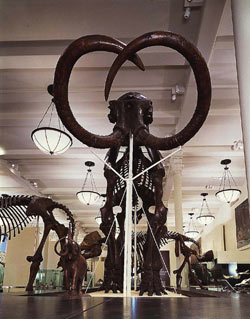Exhibition
 In a world where children have grown up watching the Jurassic Park movies and seeing animatronic dinosaurs at theme parks, it is important to remember that museum displays of fossil specimens are the “real thing,” actual remains of living creatures from the distant past. The power of real objects to inspire and inform, and their importance to the educational mission of a museum, is the main reason that museums exhibit their fossils even if this leads to restricted access for research and increased risk of damage.
In a world where children have grown up watching the Jurassic Park movies and seeing animatronic dinosaurs at theme parks, it is important to remember that museum displays of fossil specimens are the “real thing,” actual remains of living creatures from the distant past. The power of real objects to inspire and inform, and their importance to the educational mission of a museum, is the main reason that museums exhibit their fossils even if this leads to restricted access for research and increased risk of damage.
Preparators play an important role in the design and development of museum exhibits. While museum exhibition departments and commercial exhibit developers may have their own preparation staff (sometimes also called “preparators") fossil preparators have specialist knowledge in a number of areas that are critical to the successful exhibition of fossils:
Preparing or re-preparing
When preparing specimens specifically for exhibition purposes the preparator will be able to present the block in such a way to ensure stability on display. For specimens that have been previously prepared for research, some additional preparation work may be necessary to make the fossils ‘readable’ by the untrained eye.
Selecting appropriate specimens
Preparators have good insight into the stability and preservation of fossils. When there are multiple examples of a particular specimen the preparator can help determine which ones will best be able to withstand the rigors of the exhibition process. This may be particularly important if the exhibition will be traveling to multiple venues, required installation, deinstallation, and shipping of specimens.
Conservation
Before exhibition, the fossil may need to be treated to remove coatings that have discolored or flaked. Catalog and other numbers may have to be relocated in less prominent locations, and specimens that have been damaged or deteriorated over time will require repair. Preparators’ in-depth knowledge of the aging properties of glues and coatings and specimen labeling makes them ideally suited to handle this work. Visit the pages on adhesives and consolidants and labeling to access the in-depth resources on these topics.
Molding/casting
For various reasons, it may be necessary to exhibit a cast of a specimen rather than the actual fossil. As with all molding and casting of original material, there is a risk of damage to the specimen. For this reason the molding and casting of fossils is usually handled by a fossil preparator.
Mounting
Before a fossil can be exhibited, it usually needs to be placed on a mount or a supporting framework (known as an armature). The weight and fragility of fossil specimens makes this a particularly challenging task, especially if the fossils also need to be packed, shipped, and installed for the exhibit to travel to multiple venues. Mount design is another area where preparators have an important role to play. Many of the techniques employed are drawn from the literature developed by art conservators, including:
- Techniques for safe pinning and doweling (e.g., using stainless steel or titanium rather than iron pins or wire hangers)
- Archival materials for long-term display
- Designing mounts to safely withstand seismic activity
- Designs for safe crating and transport
Condition reporting
Specimens in an exhibit that travels to multiple venues will require condition reports. These reports are checked after the crates have been opened to ensure that the specimen arrived without damage. They are checked again at the end of the exhibition before packing to ensure that the specimen is in good condition and will be able to withstand travel. Preparators work with other museum staff, including conservators, collection managers, and registrars to ensure standardization of reporting methods.
Resources
- For an example of damage caused by an historic mount read the 2009 SVP poster presentation Armature damage in a mounted specimen by Robert Evander of the American Museum of Natural History
- Read the December 9, 2009 Ohio Historical Society’s collection blog entry Mobile Mastodon Skull: Creative Museum Solutions for Storage, Transport and Exhibition by Bob Glotzhober
- Carpenter, Kenneth, James H. Madsen and Arnold Lewis. 1994. Mounting of fossil vertebrate specimens. Vertebrate paleontological techniques Volume 1. Patrick Leiggi and Peter May eds. New York: Cambridge University Press.
- National Park Service Conserve-O-Gram series
- The Getty Conservation Institute has resources on protecting cultural resources from seismic activity. View their publications.
- The Journal of the American Institute for Conservation is available online.

